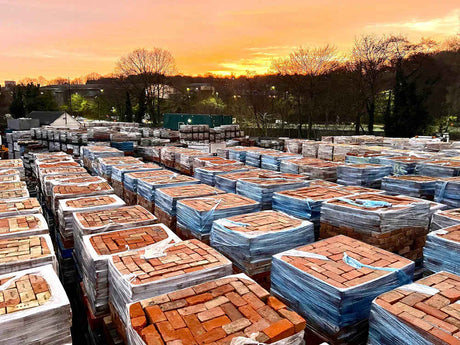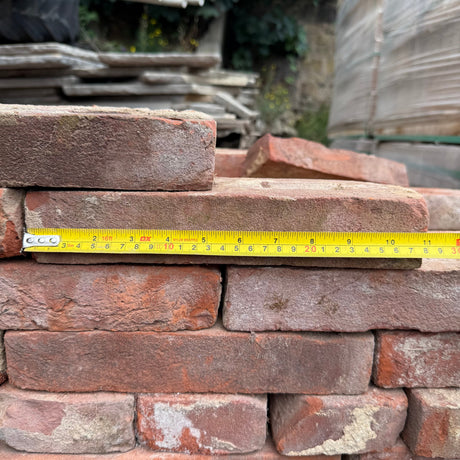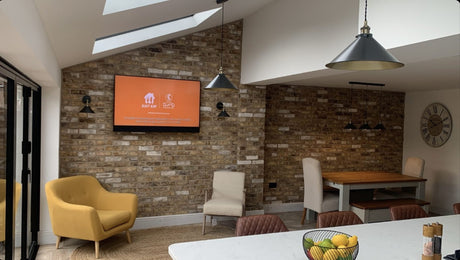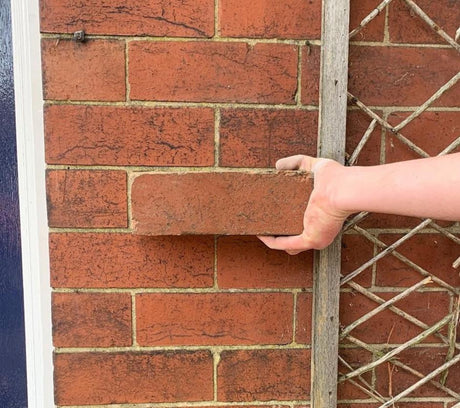Choosing the right flooring material can be a tough decision for anyone building or renovating their home. You want something that looks great but also stands up to daily wear and tear.
This is why slate is used for floor tiles, as it offers both beauty and durability in spades.
Slate tile stands out from other, natural stone tiles and flooring with its unique texture and colour range that can fit various design schemes – from rustic kitchens to elegant bathrooms. In this blog post, we'll explore what makes slate such an ideal choice for your floors, providing insights into its benefits and how it adds value to your entire home throughout.
Keep reading to discover more about this remarkable material!
What are the Unique Characteristics of Slate Floor Tiles?
Slate floor tiles are renowned for their natural splendour and varying colour palette. This stone tile, matured over millions of years, adds a unique touch to any space it adorns. With its riven finish, textures and diverse colour options, slate flooring provides a rustic yet sophisticated appearance that suits different home styles.
Its heat retention property renders it the perfect solution for underfloor radiant heating and systems, guaranteeing rooms maintain warmth for extended durations.
Furthermore, slate's durability is amongst its highly valued features. It withstands the wear and tear from heavy footfall in places like kitchens and living spaces. Plus, its high resistance to moisture enhances its suitability for bathrooms and entryways where water resistance is crucial.
Its non-slip texture promotes safety across various uses within residential or commercial environments.
Why is Slate Tile Unique?
Slate tile stands out because it blends natural beauty with impressive durability. Its unique texture and colour come from the way slate forms in layers over millions of years. Quarried directly from the earth, each slate floor tile brings a piece of ancient history into homes, making floors not just surfaces to walk on but stories to tell.
This natural stone comes in a variety of natural shades too, from grey to multicoloured, allowing architects and homeowners to create spaces that reflect their style while embracing nature's artwork.
Durability is another hallmark that makes slate tiles incredibly appealing for flooring. They withstand heavy foot traffic, resist water and scratches, making them perfect for kitchens, bathrooms, and high square foot-traffic areas in homes or commercial spaces.
The rough surface provides slip resistance, enhancing safety especially when used in rooms like showers where moisture is common. Choosing slate means investing in floors that retain heat efficiently during cooler months and contribute to a room’s warmth without additional radiant heating or sources.
How Does Natural Slate Compare to Granite?
Choosing between natural slate floor tiles and granite for floor tiles involves examining their unique characteristics. Both offer durability and beauty, but their differences can influence a decision for architects, builders, contractors, interior designers, and homeowners. Below is a comparative analysis of natural slate floor tiles versus granite.
Both materials bring distinct advantages to flooring projects. Slate's texture and colour palette lend a natural, warm aesthetic, while granite offers unparalleled hardness and a wider variety of colours. The choice between them depends on the specific needs of the project, including the desired look, budget, and the area's traffic levels.
What Makes Slate a Durable Flooring Material?
Transitioning from natural slate's comparison with granite, we delve into what elevates natural slate as a durable flooring material. Slate's resilience stems from its formation under extreme heat and pressure within the earth, making it incredibly hardwearing.
This process imbues slate with qualities that outshine other materials, especially in rooms prone to spills and moisture. Unlike some alternatives, slate maintains its integrity against scratches and dents, an essential feature for high-traffic areas of the home.
Furthermore, natural shades and variations in its composition give each tile a unique look while offering multi-coloured patterns that can hide minor wear and tear. Its low porosity makes it resistant to stains, requiring less maintenance over time compared to more porous stone tiles.
The combination of durability and aesthetic versatility makes using a natural material for slate floor tiles not just practical but also a style statement that can last for decades without losing charm or functionality.

Why Use Slate for Floor Tiles?
Slate floor tiles stand strong as one of the most resilient natural stone flooring materials for your home. Their durability makes them an ideal choice for high-footfall areas. The natural charm of slate flooring is highly valued by architects and designers and it seamlessly complements decor styles from rustic to modern.
The versatility in design options is increased by the varied range of colours available, from deep greys to vibrant rusts.
Slate tiles lend a timeless, earthy appeal to any space while boasting extraordinary durability.
Moreover, contractors frequently suggest slate due to its resistance to wear and tear. Its unique textured surface provides both visual interest and a safer, non-slip flooring option.
In rooms where resistance to moisture is paramount, such as kitchens and bathrooms, slate excels due to its natural water-repellent properties when properly sealed. Homeowners appreciate the minimal upkeep required for slate tiles; they maintain their natural allure with little effort over years.
What are the Benefits of Slate for Flooring?
Slate floor tiles are the perfect addition to any home, offering a blend of aesthetics and functionality. This natural stone tile company finds that architects, builders, contractors, interior designers, and homeowners all appreciate the unique benefits slate brings to flooring.
-
Natural slate tiles boast incredible durability. They withstand heavy foot traffic, making them ideal for living areas and patios.
-
Slate is highly resistant to moisture. Its moisture-resistant properties make it an excellent choice for kitchens and bathrooms where spills happen.
-
These tiles are resistant to wear and tear. Even in high-traffic areas, slate maintains its integrity over time.
-
They require low maintenance. A simple sealer applied every few years keeps them looking new.
-
Slate tiles come in a range of colors and patterns. Each piece is unique, adding character to your space.
-
The material retains heat well, keeping floors warmer for longer periods. It's great for radiating heat throughout the surrounding environment as the heat rises.
-
Slate is considered one of the strongest materials used for flooring. It's incredibly hard-wearing against scratches or chips.
-
With proper care, these floor tiles can last decades without needing replacement, offering exceptional longevity.
-
Their natural aesthetics provide a rustic look that complements various home styles, from traditional to contemporary.
-
Radiant heating systems work well under slate due to its ability to conduct and hold warmth efficiently.
-
Investing in slate floor tiles can add value to your home not just through their beauty but also their durability and easy maintenance.
Choosing slate means opting for a floor that combines practical benefits with natural beauty, making it a perfect choice for those renovating or updating their homes.
How Resistant is Slate to Wear and Tear?
Slate's resistance to wear and tear ranks high among flooring materials. This more natural material than stone withstands heavy foot traffic, making it a perfect medium for areas in the home or commercial spaces where durability is crucial.
Its inherent properties fend off scratches better than many other surfaces, ideal for settings with children or pets roaming about. Architects and designers often recommend slate for its longevity and minimal maintenance requirements.
This material also holds up well against moisture, which adds to its appeal for use in kitchens and bathrooms. Unlike some materials that may warp or stain when exposed to water, slate maintains its integrity even in damp conditions.
Home improvement projects that aim for both beauty and practicality benefit greatly from incorporating slate floor tiles, ensuring they remain an attractive feature of any property for years to come.
Is Slate an Ideal Choice for Kitchens and Bathrooms?
Slate tiles are incredibly popular for kitchens and bathrooms due to their natural resistance to water and stains. This makes slate an excellent material for areas prone to spills and moisture.
Its durability ensures that it stands up well against heavy foot traffic, which is common in these outdoor spaces anyway. Furthermore, the unique riven surface of slate provides a non-slip quality, making it a safe choice for wet areas.
The beauty of slate also adds a distinctive look to any room, blending well with different decor styles.
The ease with which slate can be properly maintained further enhances its suitability for kitchens and bathrooms. Simple regular cleaning keeps the tiles looking new without the need for harsh chemicals.
Slate floor tiles do require sealing after installation to ensure they remain water-resistant; however, this maintenance is minimal compared to other flooring options.
Renovate your home with the timeless appeal and lasting durability of natural slate flooring.
Moving on from specific room choices, let's consider how installing slate floor tiles can increase your property's value.

How Do Slate Floor Tiles Add Value to Your Home?
Slate floor tiles can significantly enhance your home's value due to their natural beauty and longevity. Their unique appearance, with multicoloured patterns and different textures throughout, allows them to complement different home styles effortlessly.
From modern to rustic designs, these tiles make any space look more elegant and sophisticated.
Durability is another key factor that adds value. Slate tiles are known for lasting decades without showing significant wear or damage. This makes them a wise investment for homeowners looking for flooring options that require minimal maintenance yet retain heat effectively, ensuring a comfortable environment all year round.
Compared to ceramic tiles, slate offers superior resistance to scratches and cracks, ensuring your floors look pristine for longer durations.
Can Slate Tiles Complement Different Home Styles?
Slate tiles offer a versatile flooring option that easily matches various home styles. The natural beauty of slate, with its multicolored surface and textured finish, brings warmth and character to interiors.
Architects and interior designers often recommend using slate as laminate flooring or tiles due to their ability to blend seamlessly with both contemporary and traditional décors. Whether it’s laying them in a modern kitchen or incorporating them into a rustic living room setting, slate ensures the space retains heat while adding an elegant touch.
This material demonstrates great flexibility by complementing furniture from different eras and adapts well to outdoor elements for either barefoot comfort in outdoor elements in residential spaces or high-traffic areas in commercial settings.
Its durability makes it highly resistant to cracks, further proving it as an investment for any homeowner seeking longevity alongside style. Homeowners appreciate how these tiles can elevate the appearance of their property while builders value the practical benefits they provide over time.
Do Slate Tiles Last for Decades?
Continuing the conversation on how slate tiles can improve various home styles, it's vital to discuss their long-lasting nature. Numerous homeowners and industry professionals turn to slate for its high cost and enduring quality.
Authorities concur that with the right care, these tiles can surely serve a home for many years. The inherent sturdiness of slate makes it resilient to the common wear and tear in high-traffic areas.
Its capacity to store heat also adds to its long-term performance in numerous settings throughout the United Kingdom.
Maintenance is essential in prolonging the lifespan of slate floor tiles. Applying protectors periodically safeguards floor structure against stains and moisture, which could otherwise affect their strength over time.
This regular care confirms that slate floors maintain their aesthetic charm but also stay efficient and solid year after year. Homeowners in search of a flooring material that marries attractiveness with durability will see that slate fulfils all the criteria, making it an optimal choice for any property that wants both style and substance.
How Do Slate Tiles Compare to Ceramic Tiles?
Slate tiles offer unique benefits compared to ceramic tiles, making them a distinctive choice for flooring. Their natural beauty and durability are just the beginning. Here's a detailed comparison in a straightforward format.
Slate tiles stand out for their natural beauty and longevity, offering a premium option for those seeking durability and a unique aesthetic. Ceramic tiles, while practical and cost-effective for certain applications, do not match slate's robustness and distinctive character. For architects, builders, and homeowners prioritising longevity and aesthetic appeal in their projects, slate tiles emerge as a superior choice.
What Should You Know About Maintaining Slate Floor Tiles?
Maintaining slate floor tiles demands consistent care to uphold their aesthetic appeal and durability. They must be sealed shortly after installation to ward off stains and damage from spills.
This process calls for repetition every few years, subject to foot traffic and usage of the space. For routine cleaning, acidic cleaners should be sidestepped as they can etch the slate's protective surface further.
The better choice would be a mild detergent or a cleaner created specifically for natural stone. Swiftly wiping spills will further guard natural stones against staining.
Right maintenance assures your slate floor tiles stay a durable and attractive element in your locale.
It becomes vital to examine your tiles routinely for any indications of wear or tear. Any dislodged or impaired tiles should be fixed swiftly to make future repairs and avert subsequent problems. Moreover, using mats at entries could minimise the entry of filth and grit onto the slate laminate flooring, potentially scratching its protective surface further over time.
Finally, contemplate on applying a sealant yearly in areas of heavy footfall to sustain the highest level of protection against wear and tear.
How Should Slate Tiles be Properly Maintained?
Proper maintenance ensures slate floor tiles retain their natural beauty and durability for years. Regular upkeep also helps in avoiding common issues that might affect their appearance and longevity. Here are the steps to properly maintain slate tiles:
-
Sweep or vacuum regularly to remove dust and debris. This prevents scratches.
-
Clean spills immediately to avoid stains. Slate is a natural stone that can absorb liquids if not sealed properly.
-
Use a mild detergent and warm water for cleaning. Harsh chemicals can damage the slate's surface.
-
Apply sealant annually to protect the tile from stains and moisture. Ensure the slate is completely dry before sealing.
-
Avoid dragging furniture across slate flooring to prevent scratches.
-
Place mats at entrances to reduce the amount of dirt brought onto the slate floors.
-
In areas with high foot traffic, reapply sealant more frequently to maintain the tiles' resistance to wear and tear.
-
Fix any chips or cracks promptly to prevent them from worsening. Small repairs can save you from needing a complete replacement.
-
For outdoor slate tiles, remove snow and ice carefully during winter months to avoid surface damage.
-
Inspect grout lines periodically for signs of wear and apply new grout when necessary to keep the installation secure.
Following these steps will help ensure your slate floor tiles are also protected against common problems while highlighting their unique qualities as a durable material to use in various spaces of your home.
What are Common Issues with Slate Floor Tiles?
Slate floor tiles offer undeniable beauty and durability, making them a popular choice for both homes and commercial spaces. However, they do come with their set of challenges that architects, builders, contractors, interior designers, and homeowners need to consider.
-
Slate tiles are prone to scratching. Despite their overall durability, the surface can get scratched by furniture legs or sharp objects.
-
Water absorption is another issue. If not sealed properly, slate can absorb water which leads to staining.
-
Tiles might crack under heavy pressure. Heavy furniture or accidental drops can cause cracks in the slate tiles.
-
Inconsistency in tile thickness can occur due to the natural quarrying process which may lead to uneven flooring if not installed carefully.
-
Colour fading happens over time when exposed to direct sunlight for prolonged periods.
-
Maintenance needs are higher compared to other materials like ceramic tiles; slate requires regular sealing to maintain its resistance to stains and water.
-
Slate's initial cost might be higher than other flooring options due to quarrying and processing requirements.
-
Efflorescence can appear as a white powdery residue on the surface of the slate caused by water carrying mineral salts from below the surface of the stone.
-
Retaining heat in colder climates could be an issue; without underfloor heating solutions, slate floors can feel very cold underfoot during winter months.
Addressing these common issues with thorough planning professional installation, and proper maintenance ensures that slate floor tiles continue to add value and beauty to any space for years to come.

Are Slate Tiles More Resistant to Scratches?
Slate floor tiles stand out for their scratch resistance, making them a top choice in areas of high foot traffic. The natural properties of slate give it an edge over softer materials that easily show wear and tear.
Homeowners and professionals often choose slate for this very reason. Its durability ensures that the beauty of the flooring lasts longer without showing signs of scratches or damage.
Maintaining these tiles requires less effort than one might anticipate. Regular sweeping and occasional sealing keep them looking pristine. This ease of maintenance adds to its appeal why is slate used for floor tiles in both residential and commercial spaces.
Next, let's explore how slate tiles compare to other natural stone tiles and flooring materials in terms of value addition to your home.
Are Slate Floor Tiles a Good Investment?
Investing in slate floor tiles is highly regarded as a superb selection for architects, builders, contractors, interior designers, and homeowners. The unique characteristics of slate floor tile set it apart for its durability and visual attraction.
Its inherent resilience against wear and tear enables the slate flooring to meet the demands of high-traffic areas. Its resistance to scratches simplifies upkeep relative to other materials.
Furthermore, slate's aptitude to blend with various home styles while significantly enriching the real estate value is indisputable.
Experts concur that slate floors are among the most enduring investments one can make for their property. They heighten beauty and also influence positively on the market value of your home.
In comparison, while ceramic tiles may elicit short-term savings, they fall short in persistence and ageless elegance that accompany natural stone like slate.
Slate floor tiles denote a combination of elegance and strong functionality that is unparalleled by most other flooring options.
Transitioning to comprehend how these sturdy tiles necessitate particular care will safeguard their lastingness and uphold their allure over multiple decades.
Why is Slate Often Considered an Excellent Material?
Slate earns high marks as an excellent material for several reasons. Many choose slate for its natural beauty, which adds a unique charm to any space. Its rich texture and variety of colours bring life and warmth to interiors.
This natural stone stands out not just for aesthetics but also because it lasts a long time.
This durability stems from natural slate floor tiles's resilience against wear and tear, making it ideal for high-traffic areas in homes or commercial spaces. Slate floor tiles resist water well, which means they work great in kitchens and bathrooms where moisture is common.
Architects and designers often recommend slate because it needs little maintenance to keep looking good over the years.
How Do Slate Tiles Compare to Other Natural Stone Flooring Materials?
Slate tiles offer unique advantages over other natural stone flooring materials, making them a popular choice for architects, builders, contractors, interior designers, and homeowners. Their comparison with other natural stones, like granite and marble reveals their distinct characteristics in terms of beauty, durability, and maintenance.
This table highlights how slate stands out, particularly in terms of durability and maintenance. Its natural beauty, coupled with resistance to wear, makes it an excellent choice for areas with heavy foot traffic. While granite offers unmatched hardness and resistance to scratching, it comes with a higher price tag and lacks the earthy tones of slate. Marble, with its classic beauty, requires more care to maintain its appearance, making it less suited for high-traffic areas. Slate's balance of features positions it as a versatile and practical option for flooring, combining aesthetic appeal with functionality.
What Value Do Slate Tiles Add to Your Home?
Slate floor tiles are one element that can significantly elevate a home's market value and aesthetic appeal. They offer a timeless beauty that complements different home styles, from traditional to modern.
Their natural variation in colour and texture brings an earthy warmth to any room, making slate an often sought-after material for interior designers and homeowners alike.
These tiles last for decades without showing significant wear, outperforming many other flooring materials like carpet or ceramic tiles in terms of durability and maintenance required.
Architects appreciate the resilience of natural slate floor tiles structure against scratches, which makes it ideal for high-traffic areas like kitchens and bathrooms. Choosing slate floor tiles means investing in a surface that retains its elegant appearance year after year while enhancing the overall value of your property.
Conclusion
Exploring the attributes of slate as a choice for floor tiles shows its unparalleled beauty and resilience. Its unique nature sets it apart, offering homes a blend of timeless elegance and enduring quality.
Practical and efficient to maintain, this flooring option stands up well against daily wear, even in high-traffic areas like kitchens and bathrooms. Homeowners find value in slate's ability to elevate home styles while ensuring long-lasting appeal.
Reflect on how slate can create and transform your living and outdoor spaces with its natural charm and strength.








